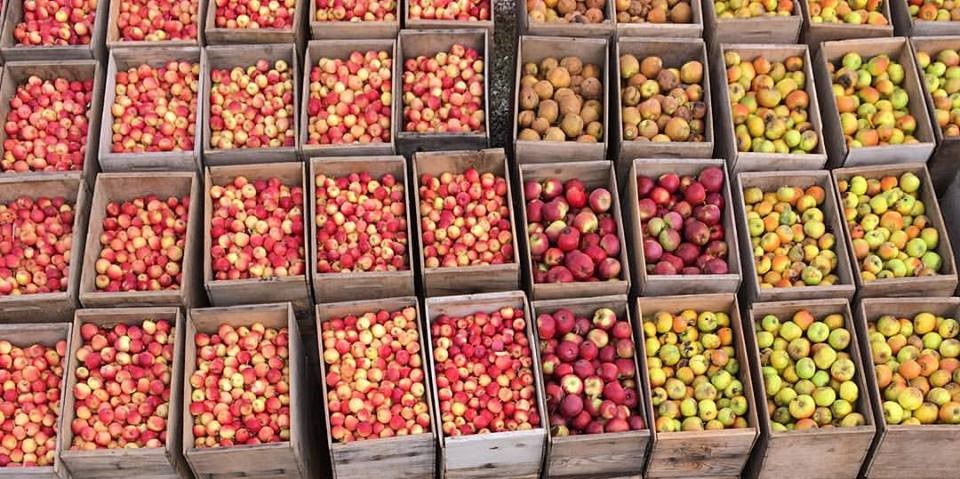Performance of Cider Apple Cultivars in the Intermountain West
A survey of cider apple growers, March 2020
Orchards providing information for this survey were kept anonymous. We greatly appreciate their willingness to participate in this survey and share their experience and knowledge. Survey results are available online at: http://agresearch.montana.edu/warc/research_current/cider_cultivar_research.html
This project was funded by the Montana Department of Agriculture Specialty Crop Block Grant.
Photo Credits: Matthew LaRubio, Michael Billingsley, and Katrina Mendrey.
Contributing authors
Zachariah Miller, Associate Professor and Superintendent
Katrina Mendrey, Orchard Program Manager
Amy Darling, Research Assistant
Executive summary
Cider orchards in the Intermountain West (IMW) have little information to guide decisions about which cultivars to grow in the high elevation, cold, and semi-arid climate. Growing conditions in this region are considerably different than traditional cider regions in Europe, where most cider cultivars have been grown for centuries. Research is currently underway at the Western Agricultural Research Center in Corvallis, MT, to provide information about cultivar performance for cider orchards in the IMW. However, this research is still young, with trees entering production in 2020 and only six cultivars under consideration. Several orchards have been planted over the past 10 years around the region, contributing valuable experience to supplement this research.
This survey was conducted to provide more immediate information to growers then research that is currently underway. The survey was conducted in two parts from March 2018 to November 2019. Survey One was used to collect information on what was planted and to prepare orchards with resources to complete Survey Two. Participating orchards were asked to take notes and assess their cultivars during the span of one growing season. Survey Two focused on rating cultivars for vigor, cold hardiness, fire blight susceptibility as young and mature trees, biennialism, bloom time and length, harvest time and ease, as well as yields. Both surveys were sent to 51 orchards or cideries thought to also grow cider apples in a geographic area defined as east of the Cascades, USDA cold hardiness Zones 6 or below and above 1,000 feet. Of those sent the survey, 23 orchards provided information on orchard management challenges, the cultivars they grew, the age of these trees and which cultivars they may have discontinued for various reasons. Sixteen orchards participated in Survey Two, providing cultivar-specific ratings.
Due to the young age of many of the surveyed orchards (average age 3.9 years), ratings were variable, and many responses to questions were rated as "unknown". Only ratings for fire blight susceptibility, bloom time, and harvest time were significantly different between cultivars. Fire blight is one of the most challenging pathogens for apple in the IMW, and where early and late frosts can often damage crops. For young trees, Bulmer's Norman had the highest susceptibility rating and was significantly different from Baldwin, Browns, Golden Russet, Harrison, Wickson and Hewe's. In mature plantings, Brown Snout had the highest reported susceptibility and was significantly different from 13 other cultivars while Wickson was reported to be the least susceptible to fire blight as a mature tree (>five years old). For bloom time, Bulmer's Norman and Harry Masters Jersey were the latest blooming cultivars and were significantly different from Hewe's Virginia Crab, Wickson and Yarlington Mill—cultivars identified as early bloomers. Hewe's Virginia Crab was consistently identified as being an earlier ripening cultivar, significantly different from Brown Snout, Bulmer's Norman and Porter's Perfection, which were identified as being later to ripen. Despite the variability and low response rate for certain cultivars, the survey provides an important inventory of cider cultivars being tested across the IMW and a window into the management challenges being faced by cider growers.
Introduction
Interest in hard cider apple production for local cidermaking has grown throughout the Western United States. In a 2018 consumer market research study led by Northwest Cider Association, “local” was selected as the most important cider characteristic by surveyed consumers. There are now local cideries in every state in the IMW, including Idaho, Montana, Wyoming, Colorado, Utah, New Mexico, and Arizona. Several cider makers have also become apple growers, hoping to gain access to desirable cider-specific cultivars difficult to acquire nationally. 43% of cideries surveyed in the 2019 NW Industry Report stated they grew their own fruit. These orchardists/cidermakers are planting new orchards with varying levels of success and can benefit from additional information about how these cultivars perform in the IMW’s unique climate.
For apple growers interested in supplying fruit to the growing cider industry, the price at which cider makers are willing to buy their apples is highly variable, largely dependent on quality. According to the NWCA 2019 Industry Report, fruit prices ranged from $0.14 per pound to $1.00 per pound. A majority of reported prices ranged from $0.35 and $0.50 per pound. With such inconsistent and low prices, cider apple growers must carefully select the cultivars they grow to minimize labor and maximize production. This survey was initiated to collate the information gathered by early cider orchards to better identify cultivars that would successfully grow in the IMW.
Methods
The survey was conducted in two parts. Survey One included 17 questions and was conducted from March 2018 to October 2018. This survey was used to identify which cultivars were being grown by orchardists and prepare them to collect a season’s worth of information if they did not keep records previously. Orchards were provided with a recordkeeping book to help them record vigor, bloom density, cold hardiness, and other attributes being evaluated in the survey. The second survey conducted from January 2019-November 2019 included 37 questions in which participants were asked to rate trees based on vigor, biennialism, fire blight susceptibility, and cold hardiness, and provide additional information on bloom and harvest times, yields, and juice quality (pH, Brix, tannins).
The survey was sent to 51 orchards and cideries identified as potentially growing the cider cultivars. In total, 23 orchards participated in one or both surveys (45% response rate). However, the participating orchards were not consistent between the two surveys. Survey One was completed by 17 orchards (33% response rate) and Survey Two was completed by 16 orchards (31% response rate), ten of those having also completed Survey One.
Participating orchards

Figure 1. Map of participating orchards. Over 50 orchards east of the Cascades in ID, OR, MT, UT, Alberta, British Columbia, and Saskatchewan received the survey. No orchards were found in WY to participate in the survey.
Orchards in the survey represent colder and higher elevation sites in western North America (Figures 2 and 3). Survey distribution was defined geographically by orchards or cideries located in USDA Cold Hardiness Zones 6 or below, east of the Cascades, and within the IMW including the following states and provinces: Alberta, British Columbia, Colorado, Idaho, Montana, Oregon, Saskatchewan, Utah, Washington, and Wyoming (Figure 1). The survey area was meant to eliminate sites with more maritime climates and focus on those in areas with predominately dry, cold conditions for which information on cultivar performance is lacking.
Most of the cider orchards in this survey are relatively new and thus have limited information on how varieties perform as mature trees. The age of participating orchards varied from 1-10 years, averaging 3.9 years, with a majority of orchards being planted less than 5 years ago. Therefore, many responses to questions characterizing cultivars were indicated as "unknown" for lack of information. In particular, questions regarding tree yields, and juice quality as mature trees received a high rate (above 50%) of unknown responses.

USDA Cold Hardiness Zones of participating orchards
Zone 4: 35.3%
Zone 5: 41.2%
Zone 6: 23.5%
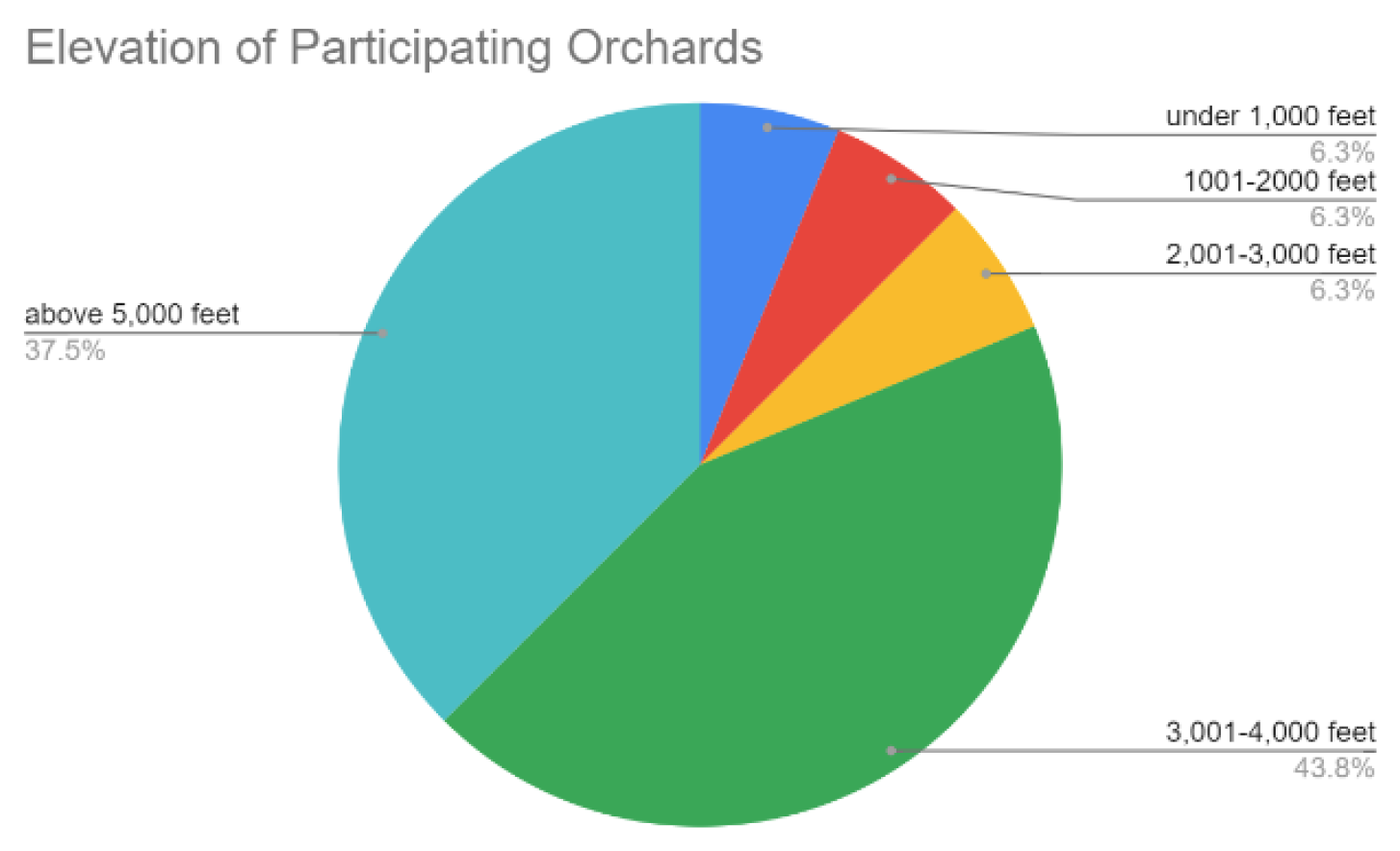
Elevation of participating orchards
< 1000 ft: 6.3%
1001-2000 ft: 6.3%
2001-3000 ft: 6.3%
3001-4000 ft: 43.8%
> 5000 ft: 37.5%
Figures 2-3. Elevation and USDA Cold Hardiness Zones of participating orchards.
Cultivar inventory

Figure 4. Summary of participating orchards' size, age, elevation and plantings.
In both surveys, orchards were asked to provide the cultivars they grew, the approximate quantity of each cultivar, and the age of the trees. Orchards specifically reported growing 87 cider type cultivars, with some orchards noting they grew 200 or more apple cultivars and could not list them as part of the survey (Appendix A). The number of apple cultivars grown by individual orchards ranged from eight to over 300.
In total, over 18,000 trees were reportedly planted by the 23 surveyed orchards. Of these, the ten cultivars listed below represent the top cultivars planted by the majority of orchards, representing 75% of the total trees planted by surveyed orchards. Orchards were also asked if they had discontinued growing any cultivars for any reason (Table 1). Fire blight was the primary reason trees were discontinued. The cultivar inventory from the first survey was used to select 20 cultivars to be included in the second survey based primarily on frequency of planting.
Top 10 cultivars planted by orchard
- Golden Russet
- Dabinett
- Kingston Black
- Wickson
- Ashmead's Kernel
- Porter's Perfection
- Harrison
- Harry Masters Jersey
- Yarlington Mill
- Chisel Jersey
Top 5 cultivars planted by total number of trees
- Golden Russet*
- Dabinett*
- Kingston Black*
- Wickson
- Harrison
*Top three cultivars represent 33% of total trees planted
Orchard management challenges
In addition to specific questions regarding cultivar characteristics, orchards were asked in both surveys to rate orchard management challenges they faced. These results are summarized in Figures 5 and 6, showing the percent of orchards rating the issue as "requiring management" or "difficult to manage" and the average rating for each issue. Though variability was high among orchard responses, a majority of orchards agreed fire blight and weed management were their biggest challenges, with 88% of growers rating these as "requiring management" or "difficult to manage". These were followed by codling moth (80%), voles (76%), and biennial production (66%). Two cultivars were rated for both susceptibility to fire blight and the tendency to bear biennially.
Cultivar characterization
Cultivars were rated based on various characteristics identified as important to successful orchard management and production. Survey participants were asked to rate each cultivar based on vigor, tendency to bear biennially, cold hardiness, and fire blight susceptibility. Participants were also asked to provide the relative bloom time, bloom length, harvest time, and harvest ease, and report yields of the cultivars they grow. Additional questions were asked about juice pH, tannins and Brix; however, response rates were low, with several orchardists indicating they did not have information about these juice quality parameters. Therefore, juice quality was omitted from the survey analysis. In place of this, a summary of values reported regionally for various cultivars’ juice chemistry is provided.
|
Cultivar
|
Number of surveyed orchards reporting removal
|
Number of surveyed orchards growing cultivar
|
% discontinuing cultuvar
|
Reason for removal
|
|---|---|---|---|---|
|
Amere de Berthcourt
|
1
|
1
|
100
|
fire blight
|
|
Brown Snout
|
2
|
5
|
40
|
fire blight
|
|
Brown's
|
1
|
5
|
20
|
fire blight
|
|
Brown Thorn
|
1
|
1
|
100
|
"not interesting"
|
|
Bulmer's Norman
|
2
|
4
|
50
|
fire blight, "not interesting"
|
|
Dabinett
|
1
|
11
|
9
|
fire blight
|
|
Ellis Bitter
|
1
|
4
|
25
|
too early
|
|
Esopus Spitzenburg
|
1
|
3
|
33
|
fire blight
|
|
Golden Russet
|
1
|
15
|
7
|
fire blight or possible winter injury
|
|
Michelin
|
1
|
2
|
50
|
fire blight
|
|
Redstreak
|
1
|
4
|
25
|
"not interesting"
|
|
Sommerset Redstreak
|
1
|
1
|
100
|
fire blight and poor producer
|
|
Stembridge Cluster
|
1
|
2
|
50
|
"not interesting"
|
|
Tom Putt
|
1
|
3
|
33
|
too early
|
|
Wickson
|
1
|
10
|
10
|
possible winter injury
|
|
Yarlington Mill
|
4
|
9
|
44
|
fire blight
|
Figures 5 and 6. Summary of orchard management issues rated by orchardists. Issues were rated on a scale of 1-3 with “1” being easy to manage “2” requiring management and “3” being difficult to manage. Though variability was high among orchard responses a majority of orchards agreed fire blight and weed management were their biggest challenges with 88% of growers rating these with a 2 or above.”


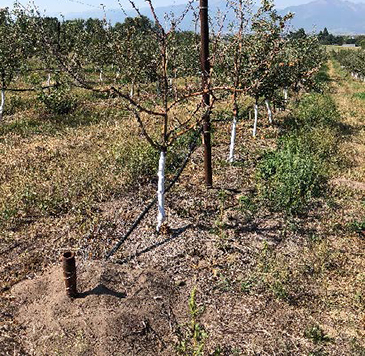
Photo 1. Vole and gopher damage in a Montana orchard. Voles girdle trees especially in winter under snow cover while pocket gophers feed on roots leading to slow tree decline as shown. Minimizing habitat by controlling weeds and mowing alleys are important control measures

Photo 2. Codling moth damage in apple. Codling moth is the primary insect pest in IMW orchards. In cider orchards it should be controlled as damaged fruit is prone to dropping and secondary injury from birds and wasps resulting in lower yields.
Results
The orchard ratings for each of the cultivars are summarized in Tables 2 and 3. As the majority of orchards were under five years old, there were some gaps in the data. Cultivars were removed from analysis if there were no data reported, or if only one orchard responded and trees were only one year old at the time of the survey. Cultivars omitted from the analysis included Marie Menard, Nehou, Newtown Pippin, Stokes Red, Ellis Bitter, White Jersey and Geneva Tremletts. Additionally, Ashmead's Kernel was inadvertently left out of several questions, and therefore, was not included in the analysis. Of the remaining cultivars, some did not consistently receive responses, or only one orchard was able to provide a rating. This lack of information is noted in the data summary, and these values should be considered with caution.
Summary of cultivar ratings
|
Cultivar
|
Vigor
|
Biennial Bearing
|
Hardiness
|
Fire blight (<5 years)*
|
Fire blight (>5 years)*
|
|---|---|---|---|---|---|
|
Baldwin
|
moderate
|
**
|
hardy
|
moderately resistant
|
moderately resistant
|
|
Binet Rouge
|
low
|
moderate
|
hardy
|
marginally susceptible
|
moderately resistant
|
|
Brown Snout
|
low
|
moderate
|
moderately hardy
|
susceptible
|
susceptible
|
|
Brown's
|
high
|
moderate
|
hardy
|
moderately resistant
|
moderately resistant
|
|
Bulmer's Norman
|
moderate
|
**
|
hardy
|
highly susceptible
|
**
|
|
Chisel Jersey
|
moderate
|
moderate
|
hardy
|
susceptible
|
marginally susceptible
|
|
Dabinett
|
moderate
|
moderate
|
hardy
|
moderately resistant
|
marginally susceptible
|
|
Frequin Rouge
|
moderate
|
moderate
|
hardy
|
moderately resistant
|
moderately resistant
|
|
Golden Russet
|
moderate
|
moderate
|
hardy
|
moderately resistant
|
moderately resistant
|
|
Harrison
|
moderate
|
moderate
|
hardy
|
moderately resistant
|
moderately resistant
|
|
Harry Masters Jersey
|
moderate
|
moderate
|
moderately hardy
|
marginally susceptible
|
marginally susceptible
|
|
Hewe's Virginia Crab
|
high
|
low
|
hardy
|
resistant
|
moderately resistant
|
|
Kingston Black
|
moderate
|
moderate
|
moderately hardy
|
moderately resistant
|
moderately resistant
|
|
Major
|
moderate
|
moderate
|
moderately hardy
|
moderately resistant
|
moderately resistant
|
|
Muscadette de Dieppe
|
moderate
|
low
|
**
|
**
|
marginally susceptible
|
|
Porter's Perfection
|
moderate
|
moderate
|
hardy
|
moderately resistant
|
moderately resistant
|
|
Redstreak
|
low
|
moderate
|
moderately hardy
|
moderately resistant
|
marginally susceptible
|
|
Roxbury Russet
|
high
|
moderate
|
moderately hardy
|
moderately resistant
|
moderately resistant
|
|
Wickson
|
moderate
|
moderate
|
hardy
|
moderately resistant
|
resistant
|
|
Yarlington Mill
|
moderate
|
moderate
|
**
|
moderately resistant
|
marginally susceptible
|
|
Cultivar
|
Bloomtime*
|
Bloom length
|
Harvest time*
|
Ease of harvest
|
|---|---|---|---|---|
|
Baldwin
|
mid
|
moderate
|
mid
|
easy
|
|
Binet Rouge
|
mid
|
moderate
|
early
|
moderate
|
|
Brown Snout
|
late
|
short
|
late
|
easy
|
|
Brown's
|
mid
|
moderate
|
mid
|
moderate
|
|
Bulmer's Norman
|
late
|
moderate
|
late
|
easy
|
|
Chisel Jersey
|
late
|
moderate
|
mid
|
easy
|
|
Dabinett
|
mid
|
long
|
late
|
moderate
|
|
Frequin Rouge
|
mid
|
moderate
|
early
|
moderate
|
|
Golden Russet
|
mid
|
moderate
|
mid
|
moderate
|
|
Harrison
|
mid
|
moderate
|
mid
|
moderate
|
|
Harry Masters Jersey
|
late
|
moderate
|
late
|
easy
|
|
Hewe's Virginia Crab
|
early
|
moderate
|
early
|
moderate
|
|
Kingston Black
|
mid
|
moderate
|
mid
|
easy
|
|
Major
|
mid
|
moderate
|
mid
|
moderate
|
|
Muscadette de Dieppe
|
mid
|
moderate
|
early
|
easy
|
|
Porter's Perfection
|
late
|
moderate
|
late
|
moderate
|
|
Redstreak
|
mid
|
moderate
|
**
|
moderate
|
|
Roxbury Russet
|
mid
|
moderate
|
mid
|
moderate
|
|
Wickson
|
early
|
moderate
|
mid
|
moderate
|
|
Yarlington Mill
|
early
|
**
|
mid
|
moderate
|
*Significant differences between cultivars were noted.
**No responses were provided.
Bolded words are those with only one orchard response available.
Vigor
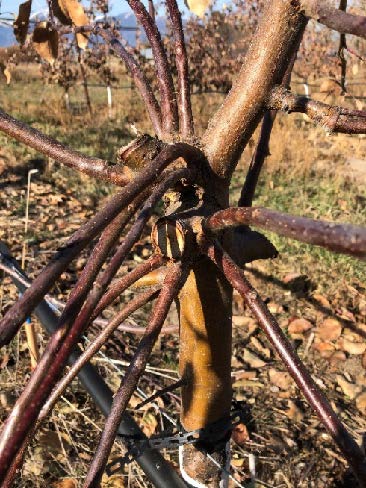
Hewe's Virginia Crab was rated as one of the most vigorous trees, shown here budding profusely from a pruning cut. However, it is also rated highly as a consistent bearing, hardy tree with low fire blight susceptibility.
Survey question: Please rate the vigor of the cultivars you grow based on a scale of 1 to 5, 1 being low vigor (I rarely need to prune these trees) and 5 being high vigor (I hate pruning these trees).
Tree vigor can present a problem for orchard managers, as highly vigorous trees take more time to prune, can result in poor fruit quality due to canopy shading, and young vigorous shoots are more susceptible to fire blight (Intermountain Fruit Guide, 2020). Tree vigor is affected by rootstock, growing conditions, and cultivars. Each of these factors was not controlled for when asking orchardists to rate the vigor of their trees in the survey. However, the survey was designed to have growers rate cultivars relative to the ones they have in their orchards, thereby alleviating some of these factors.
There was no statistically significant difference between cultivars based on survey responses (p=0.076). However, Hewe's Virginia Crab was consistently rated as having high vigor' with 100% of respondents rating its vigor above 3 (Photo 4). The average rating for Hewe's Virginia Crab was 4.25. The number of orchards able to respond to this question varied from 14 (Golden Russet) to 3 (Binet Rouge and Brown’s). Of the 129 total observations regarding tree vigor, 23% were unknown.
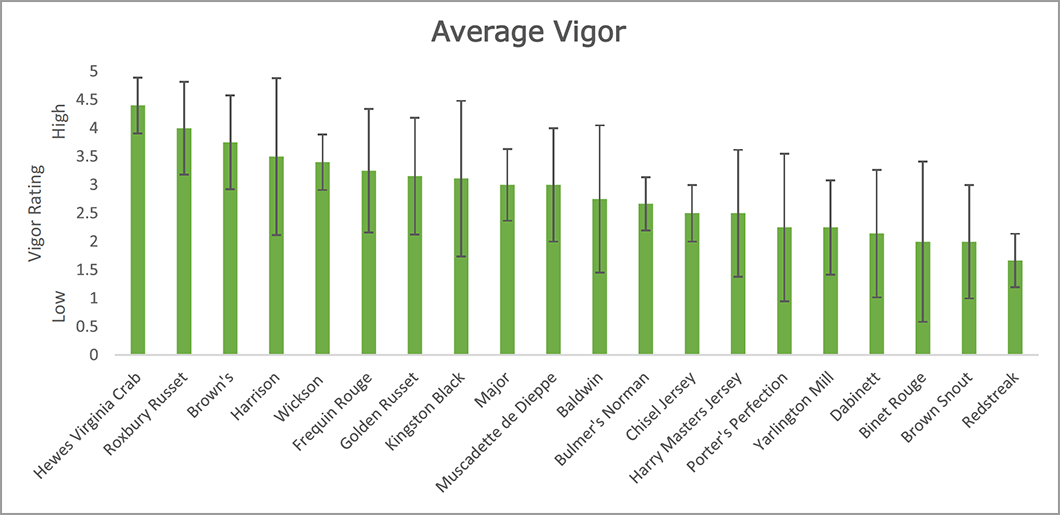
Figure 9. Average vigor of cultivars in Survey Two. Hewes was consistently rated to be a highly vigorous tree with an average rating of 4.25.
Biennialism

Frequin Rouge trees blooming in a Montana orchard demonstrating the potential variability in bloom density
Survey question: Please rate the tendency of the cultivars you grow to be biennial bearing based on the criteria provided.
Many apples, in particular heritage cultivars used for cider, are biennial-bearing, which results in inconsistent yields from year to year. Bloom density variability from year to year is an indication of biennialism (Embree et al., 2007). Respondents were asked to rate the biennialism of their trees based on the following criteria: 1 = Consistent bloom density from year to year; 2 = Bloom density varies moderately from year to year; and, 3 = Bloom density is highly variable from year to year in this crop.
Of the 115 responses to this question, 49% of observations about bloom density were reported as unknown. There were no significant differences between cultivars (p=0.669). The number of orchards able to make observations about the biennialism of specific cultivars varied from nine (Golden Russet) to one (Brown Snout, Binet Rouge and Muscadette de Dieppe). Most cultivars were rated as having moderate differences in bloom density from year to year, with Kingston Black having the greatest tendency to bear biennially. In a follow-up question, Browns, Muscadette de Dieppe, and Baldwin were noted as being barren some years in Montana and Idaho orchards; however, there were no other responses for Baldwin.

Fig. 10. Bloom density variation from year to year in cider cultivars. High bloom density variation is an indication of biennialism in apples.
Cold hardiness

Hewe's Virginia crab trees painted with latex paint to protect from sunscald.
Survey question: Please rate the cold hardiness (susceptibility to winter injury) of the cultivars you grow based on the criteria provided. These criteria are based on winters with average minimum temperatures for your plant hardiness zone and do not include colder than average winter seasons or those with abnormally sudden freezing temperatures. Another question follows to include these types of winter conditions. Winter injury also does not include bud damage from spring frosts.
Cold hardiness is an important trait in any cultivar being grown in the Intermountain West, where most growing regions are Zone 5 or below. Signs of cold injury include death or decline of whole trees; injury to tissue on crotches, terminals or limb tips; and sunscald. A tree's susceptibility to cold injury can be cultivar specific, but other factors, including the condition of trees going into winter, can be confounding. Trees that bore heavily or experienced late-season pruning or fertilization may be slow to go dormant and unprepared for winter temperatures. Drought-stressed trees can also be more susceptible to cold injury as well as trees not protected from sunscald with white paint on trunks.
In this survey, participants were asked to rate damage to trees which occurred during typical winters. Damage was rated on a scale of 1-4 using the following criteria: 1= Not cold hardy, severe die dieback or tree death; 2 = Symptoms of moderate injury including terminal limb dieback, crotch or crown damage, sunscald; 3=Moderately hardy, minor cold injury limited to terminal buds; 4 = Hardy, winter damage absent or rare.
There were 72 responses rating the cold hardiness of trees. 33% of the 111 total responses were unknown. 94% of the cultivars were rated as being on average either hardy or moderately hardy, displaying only minor cold injury after a winter with average temperatures. The cultivars with the highest ratings were Binet Rouge, Harrison and Hewe's Virginia Crab. Redstreak was rated as the least cold hardy (2.5) and was significantly different from Binet Rouge, Harrison, Hewes and Wickson (p=0.12).
Orchards were also asked to recall any winters with abnormally cold temperatures that caused subsequent injury. An orchard in Darby, MT (Zone 4), reported all cultivars—except Hewe's Virginia Crab, Brown’s, Tom Putt and Stembridge—experienced significant injury during winter of 2014, in which recorded temperatures dropped as low as -21 °F on 02/06/2014. These ratings and responses reflect that winter injury was not a major issue for a majority of the survey participants, with only two orchards in Montana rating it as a problem in all cultivars.
UPDATE: In fall 2020, Montana and many areas across the West experienced extremely low temperatures in October, reaching a 100-year record low of -6 °F on 10/25/22. WARC performed a survey of three orchards in Corvallis, Darby and Stevensville, MT. While extent of damage varied by location and tree age, Chisel Jersey, Dabinette, Frequin Rouge, Ashmead's Kernel, Golden Russet, and Roxbury Russet either died or had to be cut back to the graft union due to extensive damage. A summary of damage to cultivars in this survey can be found at https://agresearch.montana.edu/warc/research_current/apples/2020_cider_winter_injury.html.
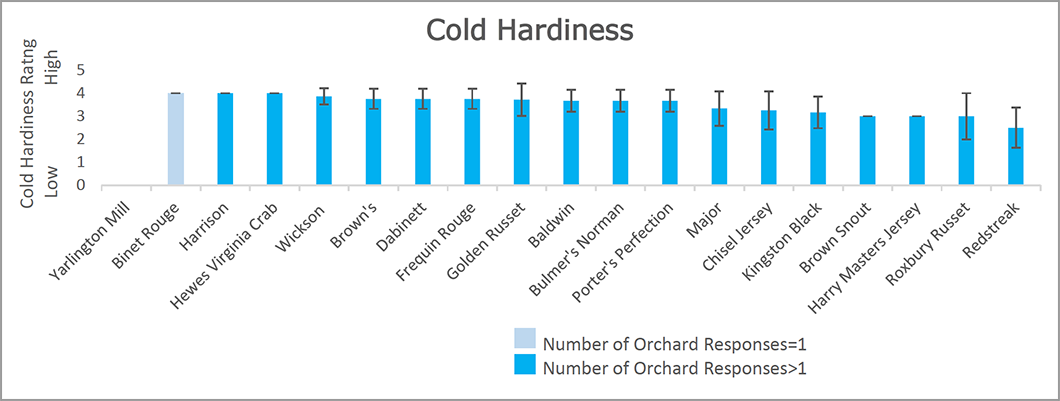
Fig. 11. Cold hardiness rating of cultivars.
Fire blight
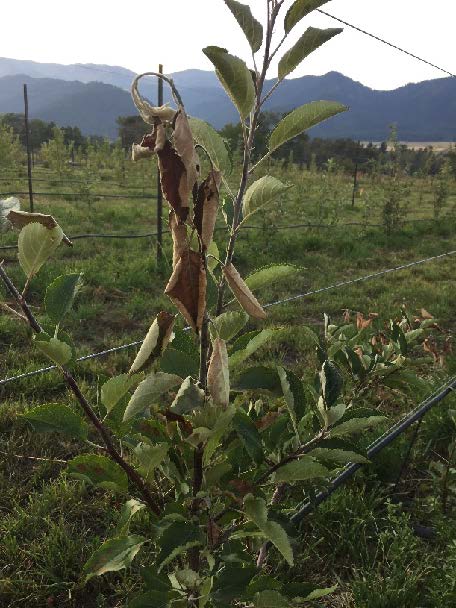
Fire blight in the shoot of a young Kingston Black tree. Many cider cultivars are susceptible to fire blight particularly as young trees. Protections include removing flowers when trees are young, timely use of effective sprays during high-risk periods in the spring and quick removal of infected materials by pruning.
Survey question: Please rate the susceptibility of your cultivars to fire blight, differentiating between young trees (less than five years old) and mature (older than five years old).
Fire blight (Erwinia amylovora), a bacterial pathogen in apples and other members of the Rosaceae family, has been identified as one of the greatest challenges facing cider orchards in the IMW (see Figure 5). Fire blight is spread under warm, moist conditions in the spring. The most common path of infection is during pollination when bacteria are transported by pollinators between flowers, where the bacteria enter the tree’s vascular system. The disease is often not an issue in maritime climates like England and Western Washington, where historical and modern research regarding the performance of these European cultivars has occurred. Fire blight is present in most apple growing areas of the IMW and is considered a primary pest in both dessert and cider cultivars.
Young trees can be more susceptible to fire blight than mature trees, as the pathogen travels more quickly in young, vigorous tissue. The warm, moist springs experienced during bloom—when the pathogen is spread—also make trees particularly susceptible in the Intermountain West where fire blight can be found on both cultivated and native members of the Rosaceae family.
Orchards were asked to rate the fire blight susceptibility of both young and mature trees using the following scale: 1 = Resistant infection rare or absent; 2 = Moderately resistant - strikes common but limited to blooms, does not spread to shoots; 3 = Marginally susceptible - strikes common in bad fire blight years; 4 = Highly susceptible - strikes common, resulting in severe dieback or total death. For young trees, Bulmer’s Norman had the highest susceptibility rating (4) and was significantly different from Baldwin, Browns, Golden Russet, Harrison, Wickson, and Hewe's (p=6.5E-05) (Figure 9). In mature plantings, Brown Snout had the highest reported susceptibility (4) and was significantly different from 13 other cultivars (p=3.2E-06) (Figure 10). Wickson was reported to be the least susceptible, with an average rating of 1. No orchards were able to rate the susceptibility of Bulmer’s Norman to fire blight as a mature tree.
Indicating the youth of orchards surveyed, only 19.5% of responses were unknown regarding the susceptibility of young trees, where as 42.6% of responses were marked as unknown regarding the susceptibility of mature trees to fire blight.

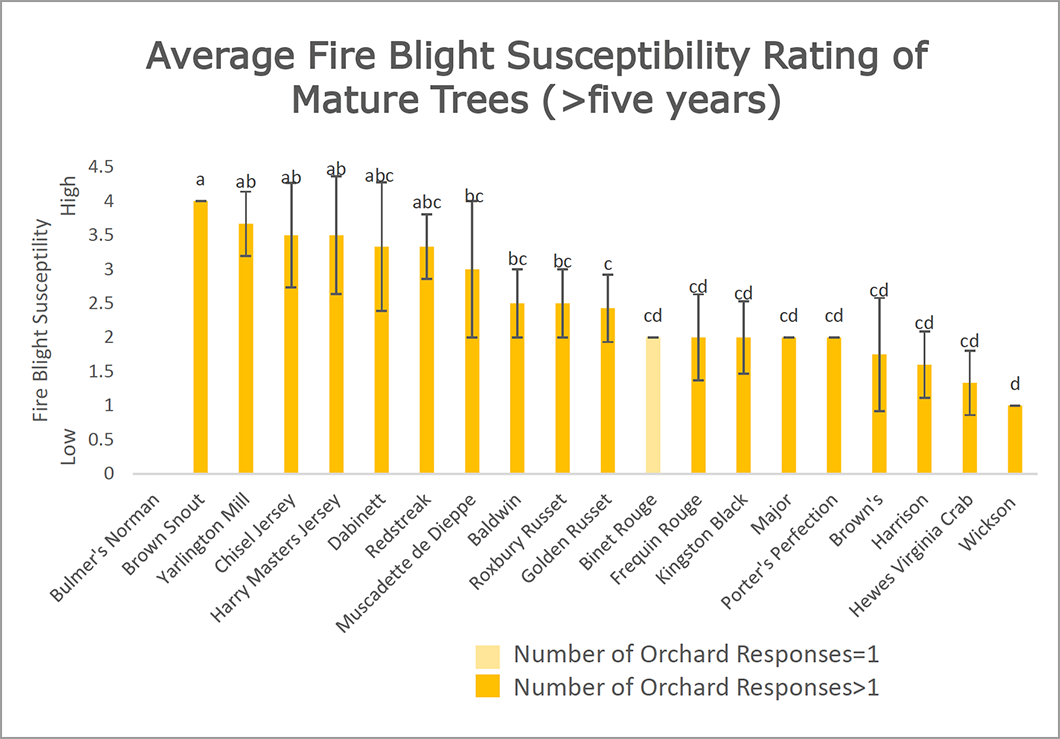
Figure 12 and 13. Figure 12. As young trees Bulmers Norman and Binet Rouge were rated by only two orchards. Golden Russet and Kingston Black received the most responses with 13 and 10 orchards rating these cultivars respectively. In mature trees, no orchards provided a rating for Bulmers Norman. The most orchards rated Golden Russet (7) followed by Chisel Jersey (6).
Bloom time and length
Survey question: Please provide information on peak bloom time for the cultivars you grow. Base the beginning of the bloom period on full bloom and the end at petal fall.
Bloom time and length is important information for growers to achieve successful pollination. Additionally, early-blooming cultivars may be more susceptible to frost and later- or longer-blooming cultivars may be more susceptible to fire blight. Orchardists were asked the approximate bloom time for the cultivars in their orchards by both reporting what month bloom began and ended in their orchard and to rate the relative bloom time of specific cultivars. Bloom time ratings of specific cultivars were categorized as early (1), mid-season (2), late (3) and inconsistent (4) relative to the other cultivars grown in the participating orchard. They were also asked to rate the bloom length of cultivars in their orchards as short (1), moderate (2), long (3) or inconsistent (4).
Orchards reported that bloom began in their orchards around mid-April to mid-May and ended in early May to late June, depending on elevation and cold hardiness zones. No orchards reported any of the cultivars they grew as having inconsistent bloom times or lengths from year to year. Bulmer's Norman and Harry Masters Jersey were the latest-blooming cultivars and were significantly different from Hewe's Virginia Crab, Wickson, and Yarlington Mill—cultivars identified as early bloomers (p=1.01E-5) (Figure 11). However, only one orchard rated the bloom time for Yarlington Mill. Dabinette was reported to have the longest bloom period followed by Harry Masters Jersey, Roxbury Russet, Frequin Rouge, Kingston Black, Major, and Porters Perfection; however, there were no significant differences between cultivars for bloom length (p=0.914) (Figure 12).
Only one orchard reported bloom times for Yarlington Mill, Binet Rouge, and Redstreak. Golden Russet received the most responses, with seven orchards reporting bloom times for this cultivar. 38.9% of responses regarding relative cultivar bloom time were unknown, whereas 51.4% of responses were reported as unknown for bloom length. Bulmer's Norman and Harry Masters Jersey were identified as being more susceptible to fire blight than Hewe's Virginia Crab and Wickson; however, Yarlington Mill was rated as highly susceptible to fire blight and reportedly removed from some orchards due to fire blight susceptibility.

Fig. 14. Bloom time of cultivars were rated as early (1), mid (2) or late (3) relative to other cultivars in each orchard.
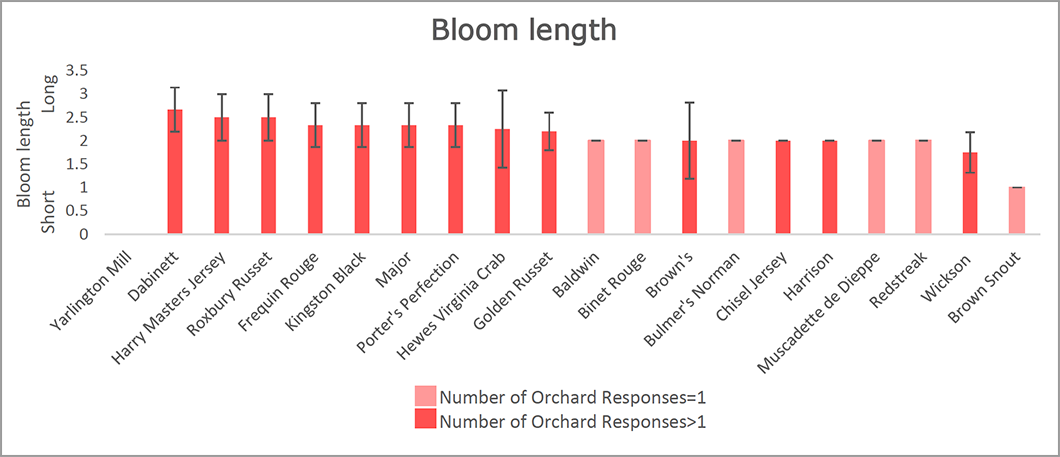
Fig. 15. Bloom length of cultivars were rated as short (1), moderate (2) or long (3) relative to other cultivars in each orchard.
Harvest time
Survey question: Please provide information on harvest time for the cultivars you grow.
Harvest time is important to growers in the Intermountain West, as early frosts can interfere with fruit ripening and juice quality, resulting in a lost crop when a season is cut short. Early-ripening cultivars can produce more reliable and consistent crops, as they are not as susceptible to damage from an early frost. Timing of fruit production can also influence when trees go into dormancy. Late-ripening trees may be more susceptible to winter injury if they are slow to go dormant and winter comes early. In fall 2019, many orchards in the IMW were hit by early frosts throughout October, ranging between 24 °F (10/01/2019) and -2 °F (10/30/2019) reported in Corvallis, MT. One grower in nearby Stevensville, MT, reported that he was unable to harvest Chisel Jersey, Harrison, Baldwin, Harry Masters Jersey, Calville Blanc, and Amere De Berthcourt apples due to frost damage. While he was able to harvest other later cultivars—including Wickson, Golden Russet, and Hudson’s Golden Gem—the fruit quality was poor.
Orchards were asked to categorize the harvest time of their cultivars as early (1), mid (2), late (3), or inconsistent (4) relative to the other cultivars in their orchards. All five of the orchards reporting harvest times for Hewe's Virginia Crab consistently identified this cultivar as being one of the earlier-ripening cultivars in their orchards. This cultivar was significantly different from Brown Snout, Bulmer’s Norman, and Porters Perfection, which were identified as being later to ripen (p=0.012) (Figure 13). Of the 116 observations reported, 46.5% of responses were unknown as to the relative harvest time of the listed cultivars, and only one orchard reported a cultivar (Brown Snout) as having an inconsistent harvest time.

Fig. 16. Average harvest time of cultivars categorized as early (1), mid (2) or late (3).
Ease of harvest
Survey question: Please rate the ease of harvest for the cultivars you grow based on the following criteria. Ease of harvest is based on the labor required to pick a similar weight of fruit.
The ease of harvest for each cultivar was rated based on a the following criteria: 1 = easy, large amounts of fruit can be removed from the tree with minimal labor; 2 = Moderate, the trees can be picked with moderate labor requirements; and 3 = Difficult, trees are tedious to pick and require more labor than others for a similar amount of fruit. Labor is one of the biggest challenges facing small orchards in the west. Often, cider orchards are not large enough to warrant mechanical harvesting, so the ability to easily harvest fruit from trees is an important consideration for an orchardist managing trees on their own.
Results from this survey indicate there were no significant differences between cultivars in terms of their ease of harvest (p=0.62). All cultivars were rated as easy or moderate in terms of their ease of harvest with average ratings ranging from 1.2 (Harry Masters Jersey) to 2.3 (Hewe's Virginia Crab). Hewe's Virginia Crab, Binet Rouge, Frequin Rouge, Harrision, and Redstreak received an average rating of 2.0 or above, with the remaining cultivars receiving ratings below 2.0 (Figure 14). 41% of observations for this question were unknown.
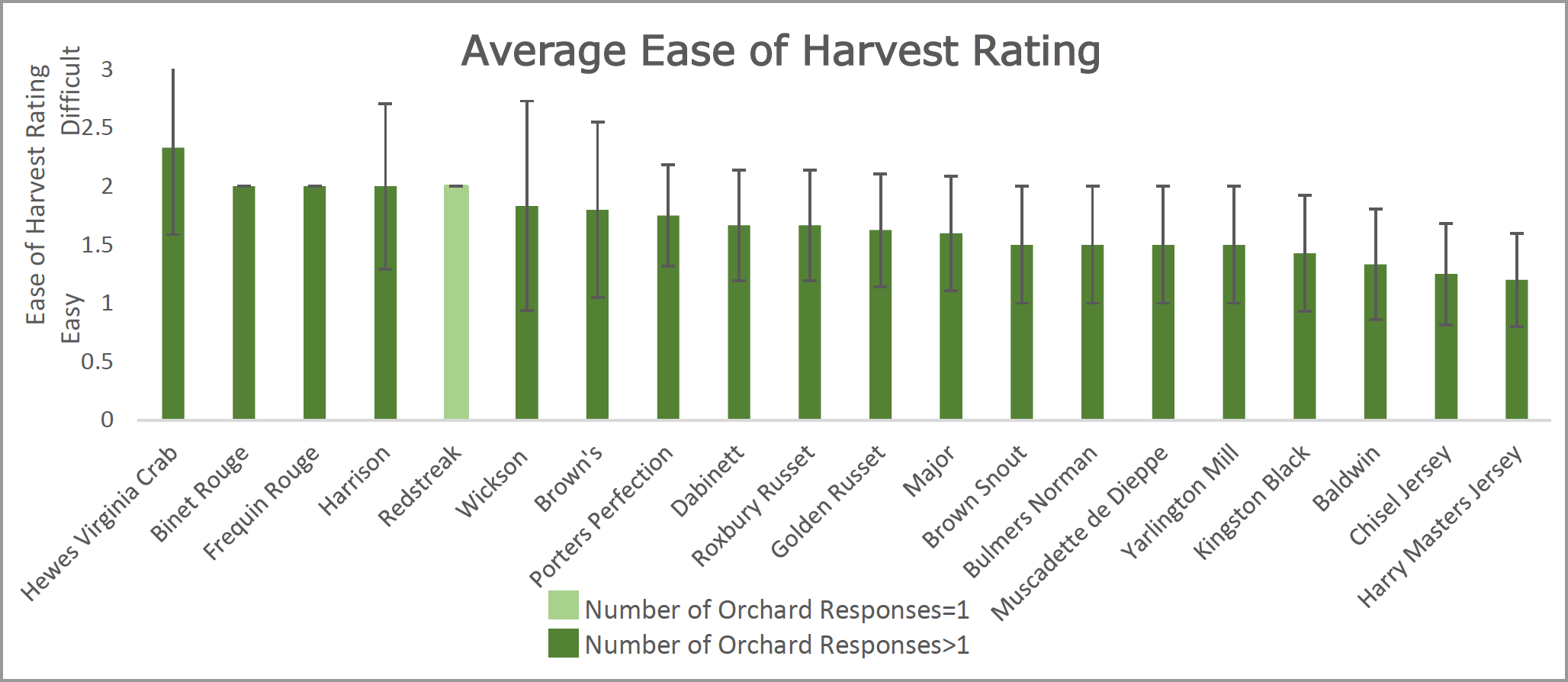
Fig. 17. Average ease of harvest rating.
Yield
Survey question: Please provide information about the yields of the cultivars you grow based on the criteria provided. Yields are in bins per acre (800 lbs/bin).
Potential yield is an important consideration in determining the economic viability of an orchard operation (Peck and Knickerbocker 2018). Yields vary considerable based on cultivar, orchard age, tree density, orchard management practices and climate, with little published or cited information available on yields for cider cultivars. What does exist is variable and difficult to draw comparisons, due to the aforementioned factors. For example, in a study comparing harvesting techniques of Brown Snout apples, Alexander, et al. (2016) reported an average yield of 14.5 bins/acre from 12- and 13-year-old trees planted 4’ apart in 16’ rows in Western Washington. Peck and Knickerbocker (2018) reported Dabinette and Michelen yield at 62.5 bins/acre in mature UK orchards, whereas in a presentation on cider apples in the UK, Macdonald (2015) reported yields on bush trees being closer to 50 bins/acre.
Using these variable reported values as a guide, orchards were asked to provide their average yields as a range using the following selections: Low (10 bins or less), Moderately Low (10.1-20 bins/acre), Moderate (20.1-30 bins/acre), Moderately High (30.1-40 bins/acre) and High (over 40 bins/acre). Given that the average age of orchards participating in this survey was 3.9 years, yield was largely unknown for many of the listed cultivars, with 61% of responses unknown. Only one orchard reported having high yields (over 40 bins/acre) for any of the listed cultivars. This was also the oldest orchard (ten years old), which reported the highest yields for all cultivars ranging from 15 bins/acre (Chisel Jersey) to 45 bins/acre (Golden Russet, Hewe's Virginia Crab, and Roxbury Russet). Below is a table providing average yields in orchards with ages and densities also averaged for each cultivar where yields were reported. These values demonstrate both the variability in yields and the general lack of information currently available.
|
Cultivar
|
Average tree age (years)
|
Density of planting
|
Average yield (bins/acre)
|
Number of orchards responding
|
|---|---|---|---|---|
|
Binet Rouge
|
10
|
100
|
35
|
1
|
|
Frequin Rouge
|
10
|
100
|
35
|
1
|
|
Harry Masters Jersey
|
10
|
100
|
35
|
1
|
|
Muscadette de Dieppe
|
10
|
100
|
35
|
1
|
|
Porter's Perfection
|
6.5
|
450
|
30
|
2
|
|
Dabinett
|
6.5
|
450
|
25
|
2
|
|
Roxbury Russet
|
7.5
|
unreported and 100
|
25
|
2
|
|
Wickson
|
6.5
|
450
|
25
|
2
|
|
Major
|
6.7
|
500
|
21.7
|
3
|
|
Golden Russet
|
5.5
|
575
|
20.7
|
7
|
|
Harrison
|
5
|
512.5
|
20
|
4
|
|
Brown's
|
6.7
|
500
|
18.3
|
3
|
|
Chisel Jersey
|
10
|
100
|
15
|
1
|
|
Hewe's Virginia Crab
|
5
|
530
|
15
|
5
|
|
Kingston Black
|
5.2
|
610
|
11
|
5
|
|
Baldwin
|
5
|
750
|
5
|
1
|
|
Bulmer's Norman
|
3
|
500
|
5
|
1
|
Juice quality
Juice quality is an important consideration for cider makers and orchardists hoping to sell their apples to cider makers. Historically, cider apples have been categorized as sweet, sharp, bittersweet, and bittersharp (Table 5) depending on the level of tannins and acidity of pressed juice (Alexander et al., 2016; Barker, 1953). Brix, an indication of sugar content, is also an important consideration for cider makers, as it influences the % alcohol of their finished cider.
|
Sharp
|
Low Tannin < 0.2*
|
High Acid > 0.45%
|
|---|---|---|
|
Bittersharp
|
High Tannin > 0.2%
|
High Acid > 0.45%
|
|
Sweet
|
Low Tannin < 0.2%
|
Low Acid < 0.45%
|
|
Bittersweet
|
High Tannin > 0.2%
|
Low Acid < 0.45%
|
All other juice analyses were performed in WARC's laboratory. All cultivars were grown at WARC in Corvallis, MT unless otherwise noted. For non-producing cultivars in 2020, % tannic acid is unavailable; however, total tannins (mg/L) and total phenolics (mg/L) (using the Harbertson assay), are compared in Figures 1 and 2, allowing for relative comparisons with other cultivars.
Participants were asked to rate the quality of the juice produced by the cultivars they grow. Juice quality parameters for specific cultivars were largely unknown by orchards, with 58%, 63%, and 64% unknown responses for Brix, tannins and pH respectively. Due to this lack of information, these results were not reported; however, several studies have reported values for some of the cultivars included in this survey. These studies include apples grown in Washington, Colorado, Montana, and British Columbia. To allow for comparison only tannin results reported using the Lowenthal-Permanganate method were listed as other methods do not allow for direct comparison with this method.
These results are summarized in Table 7 and demonstrate the variation in juice quality within a single cultivar. The classifications listed in Table 7 are based on the reported values and not the historical LARS classification. This variation cannot be explained by simple regional differences in growing conditions as determined by Alexander, et al. (2016). In a study comparing juice quality parameters of four cider cultivars grown in two different regions of Washington, Alexander, et al. (2016) found no significant differences between pH, acid, tannins or soluble solids. Additionally, fruits traditionally classified as bitter, did not have high enough tannin content to be classified as such. Some research suggests this variability may be explained by growing conditions with stressed trees resulting in higher tannins (Alexander, et al. 2016; Lea, 2008). More research is needed to determine what factors drive the variation in tannin content as bitter apples are more commonly grown in cider orchards for the complexity they add to craft cider. For a given variety, tannin content can vary by ten to twenty-fold among years and orchards (Table 6).
|
Cultivar
|
pH
|
TA%
|
Tannins (%) L-P
|
Brix
|
Classification
|
|---|---|---|---|---|---|
|
Brown Snout
|
3.64-3.94†
|
0.31-0.37†
|
0.13†-0.16
|
12.90
|
Sweet
|
|
Brown's
|
3.12*-3.23
|
0.74
|
0.10-2.00*
|
10.2-15.10*
|
Sharp, Bittersharp
|
|
Bulmer's Norman
|
4.09-4.10**
|
0.22-0.30*
|
0.20
|
11.3-14.0*
|
Sweet, Bittersweet
|
|
Chisel Jersey
|
4.31
|
0.25
|
0.42
|
13.8
|
Bittersweet
|
|
Dabinett
|
3.26*-4.41
|
0.16†-0.47*
|
0.17-1.4
|
13.5-15.3*
|
Sweet, Bittersweet, Sharp, Bittersharp
|
|
Frequin Rouge
|
4.17
|
0.26
|
0.30
|
11.4
|
Bittersweet
|
|
Golden Russet
|
3.4**-3.6**
|
0.60**-0.93**
|
0.10
|
15.40
|
Sharp
|
|
Harrison
|
3.20*-3.46
|
0.64-0.95**
|
0.10
|
14.6-16.1**
|
Sharp
|
|
Harry Masters Jersey
|
4.34
|
0.19
|
0.21
|
12.5
|
Bittersweet
|
|
Hewe's Virginia Crab
|
3.29-3.7**
|
0.91-1.03**
|
0.19
|
14.8-21.3**
|
Sharp
|
|
Kingston Black
|
3.29*-3.6**
|
0.49*-0.61
|
0.1-0.8*
|
13.3-18.2**
|
Sharp
|
|
Major
|
4.23
|
0.2-0.87**
|
0.21
|
12.9
|
Bittersweet, Bittersharp
|
|
Muscadette de Dieppe
|
4.12
|
0.26
|
0.21
|
14.2
|
Bittersweet
|
|
Porter's Perfection
|
3.2-3.8**
|
0.50**-0.93
|
0.30
|
13.0-15.2**
|
Bittersharp
|
|
Redstreak
|
3.18
|
0.95
|
0.09
|
11.7
|
Sharp
|
|
Roxbury Russet
|
3.4**-3.5
|
0.61-0.78**
|
0.08
|
15.5**-15.9
|
Sharp
|
|
Wickson
|
3.3**
|
0.87**
|
ND
|
14.9**
|
N/A
|
|
Yarlington Mill
|
3.7*-4.1
|
0.19†-0.23
|
0.18-2.00*
|
11.9-12.9*
|
Sweet, Bittersweet
|
Washington State University, Cultivar Performance Gallery, https://cider.wsu.edu/ciderweb/. 2/27/20.
*Bors, Bob. (2014). "Breeding of Grapes and Apples with Emphasis on Juice Products and Rootstocks.” University of Saskatchewan. http://www.agriculture.gov.sk.ca/apps/adf/ADFAdminReport/20100079.pdf
**WARC Cider Juice Analysis performed by Bridgid Jarret and Rachel Leisso Fall 2019 (unpublished).
ϮAlexander, Travis & King, Jacqueline & Zimmerman, Andrew & Miles, Carol. (2016). Regional Variation in Juice Quality Characteristics of Four Cider Apple ( Malus ×domestica Borkh.) Cultivars in Northwest and Central Washington. HortScience. 51. 1498-1502. 10.21273/HORTSCI11209-16.
Summary
The performance of cider cultivars and the quality of fruit they produce is dependent on several factors with climate a primary influence. To date, research has focused on cultivar performance in areas with maritime climates where frost risk and fire blight susceptibility are lower. This lack of regionally specific information has left growers in the Intermountain West with little information to determine the best cultivars to grow for a successful cider orchard. Several cider growers in the IMW have experimented and trialed cultivars on their own providing the basis for the information in this survey, however, many of these orchards are young and have limited records to provide data on tree performance.
While this survey provides an inventory of what has been grown to date and some anecdotal information from growers, the age of orchards and low response rate provided variable and insignificant results when rating cultivars based on vigor, biennialism, cold hardiness, bloom length, ease of harvest and information regarding yields and juice quality. Significant differences between cultivars were found for fire blight susceptibility, bloom time and harvest time. All three of these categories are important considerations for IMW growers when selecting cultivars for productivity and long-term yields. These factors influence tree survivability, yields and the quality of fruit at harvest. They are important considerations for any orchardists planning a successful and productive cider orchard.
Appendix A. Cultivars grown by surveyed orchards.
Cultivars with * following their name were grown by 5% or more of surveyed orchards.
Amere de Berthcourt, Antonavka, Arkansas Black, Ashmead's Kernel *, Ashton Bitter, Baldwin *, Beacon, Bedan, Binet Blanc Dore, Binet Rouge *, Black Twig, Bramley Seedling, Bramtot, Brown Snout *, Brown Thorn, Brown's *, Bulmer’s Norman *, C'Huero Biz Bras, C'Huero Ru Bienn, Calville Blanc, Campfield, Cartigny, Chisel Jersey *, Collaos, Cox's Orange Pippin *, Crimson King, Dabinett *, Damelot, Domaines, Egremont Russet, Ellis Bitter, Esopus Spitzenburg, Fillbarrel, Frequin Rouge *, Fuero Rous, Geneva Crab, Geneva Tremlett's *, Gold Rush, Golden Russet *, Graniwinkle, Grimes Golden, Gros Bois, Gros Frequen, Harrison *, Harry Masters Jersey *, Hewe's Virginia Crab *, Hudson's Golden Gem, Kingston Black *, Kronebush, Le Bret, Major *, Marachal, Marie Mernard *, Marin Onfroy, Mattais, Meaille D'Or, Meddaille D'Or, Michelin, Muscadett De Bernay, Muscadette de Dieppe *, Nehou *, Newtown Pippen, Noel de Champs, NY58-22, Peau D'Ane, Porter’s Perfection *, Puget Spice, Redfield *, Redstreak *, Rein des Pommes *, Roxbury Russet *, Saint Edmunds Pippin *, Sommerset Redstreak, St. Martin, Stamen, Stembridge Cluster *, Stoke Red, Sweet Coppin *, Tardive Forestiere, Tom Putt *, Tomkins King, Vagon Archer, Vilberie, White Jersey, Wickson *, Yarlington Mill *, Zaberago Rinette
Appendix B. Grower recordkeeping book.
While this survey evaluates 20 cider cultivars, many more cider apple cultivars have not been evaluated for production in the cold, dry climate of the Rocky Mountain West. Little is known about their phenology, cold tolerance, and susceptibility to diseases under these growing conditions. The purpose of this online record book is to provide a format for growers to enter relevant information from season to season to vet cider apple cultivars you are new to growing. A downloadable version can be found at http://agresearch.montana.edu/warc/research_current/cider_cultivar_research.html.
The document is meant to be customized to your needs as a grower and is not protected from editing in any way. The worksheets are formatted to be easily printed for use in the orchard. The default list of cultivars are those identified as having been planted in the Rocky Mountain West and simply provide an example of what a grower's list might include. This list, like other features, are customizeable based on your needs and what you grow.
Growers interested in contributing information about the cultivars they grow to the Intermountain West Cider Cultivar Research Project can contact WARC at 406-961-3025.
The record book includes the following:
Cultivar Inventory: This worksheet is for growers to track how many trees of each cultivar they have planted. It can be used as a baseline to calculate survivability of a cultivar over time. It also can be used to keep notes on nurseries, quality of plant material, tree costs etc.
Cold Injury: Allows growers to rate winter injury in various cultivars to determine if trees are cold hardy and can withstand fluctuating temperatures and extreme minimum winter temps.
Spring Phenology and Bloom Density: Tracks growth stages of various cultivars from silver tip to petal fall. Spring phenology can influence cultivar susceptibility to frost damage, timing of pest management and risk to fire blight damage among other things. Bloom density can be an indication of a trees tendency toward biennialism.
Fire Blight: Fire blight has been identified as an important pest in cider apple production in the west. Several cultivars appear to be susceptible and how they are managed may depend on their bloom timing and length.
Harvest and Yield: This worksheet can be used to track harvest yields from year to year.
Pest Management: Allows growers to record pest pressure and control measures to track impacts overtime.
General Orchard Management: A catchall for orchard floor management, irrigation, pruning and other tasks growers want to record.
Sources
Alexander, Travis & King, Jaqueline & Scheenstra, Edward & Miles, Carol. (2016). Yield, Fruit Damage, Yield Loss, and Juice Quality Characteristics of Machine- and Hand-harvested 'Brown Snout Specialty Cider Apples Stored at Ambient Conditions in Northwest Washington. HortTechnology. 26. 614-619. 10.21273/HORTTECH03474-16.
Alexander, Travis & King, Jacqueline & Zimmerman, Andrew & Miles, Carol. (2016). Regional Variation in Juice Quality Characteristics of Four Cider Apple ( Malus ×domestica Borkh.) Cultivars in Northwest and Central Washington. HortScience. 51. 1498-1502. 10.21273/HORTSCI11209-16.
Barker B.T.P., Burroughs L.F. (1953) Cider apple varieties then and now: A survey of vintage-quality trials p. 45–55. In: T. Wallace and R.W. Marsh (eds.). Science and fruit. Univ. Bristol Bristol UK.
Bors, Bob. (2014). "Breeding of Grapes and Apples with Emphasis on Juice Products and Rootstocks.” University of Saskatchewan.
Cline, John A. (2018). Horticulture and Juice Quality Attributes of European Apple Cider Cultivars. University of Guelph.
Embree, Charles G, Myra, Marina TD, Nichols, Douglas S, & Wright, A Harrison. (2007). Effect of Blossom Density and Crop Load on Growth, Fruit Quality, and Return Bloom in ‘Honeycrisp’ Apple. HortScience., 42(7), 1622-1625.
Macdonald, Neil. “English Cider Apples and Orchard Systems.” UVM Fruit News. March 2015. http://www.uvm.edu/~fruit/treefruit/tf_cider/MacdonaldWLCider033015.pdf.
Murray, M., Larson, H., McCammon, T., & Kerzicnik, L., (Eds.) (2020). Intermountain Fruit Commercial Fruit Production Guide. Utah State University.
Northwest Cider Association. “Northwest Cider Industry Report.” NWCA Member Benefits. https://www.nwcider.com/member-benefits/northwest-cider-industry-report-2019/. Web 27 Feb. 2020.
Northwest Cider Association. “NWCA Consumer Market Research: Profile of New Drinkers.” https://www.nwcider.com/member-benefits/consumer-market-research/. Web 27 Feb. 2020.
Peck, Gregory, and Whitney Knickerbocker. (2018)."Economic Case Studies of Cider Apple Orchards in New York State." Fruit Quarterly 26:5-10.
Washington State University. “Cultivar Performance Gallery.” https://cider.wsu.edu/ciderweb/. Web 27 Feb. 2020.

